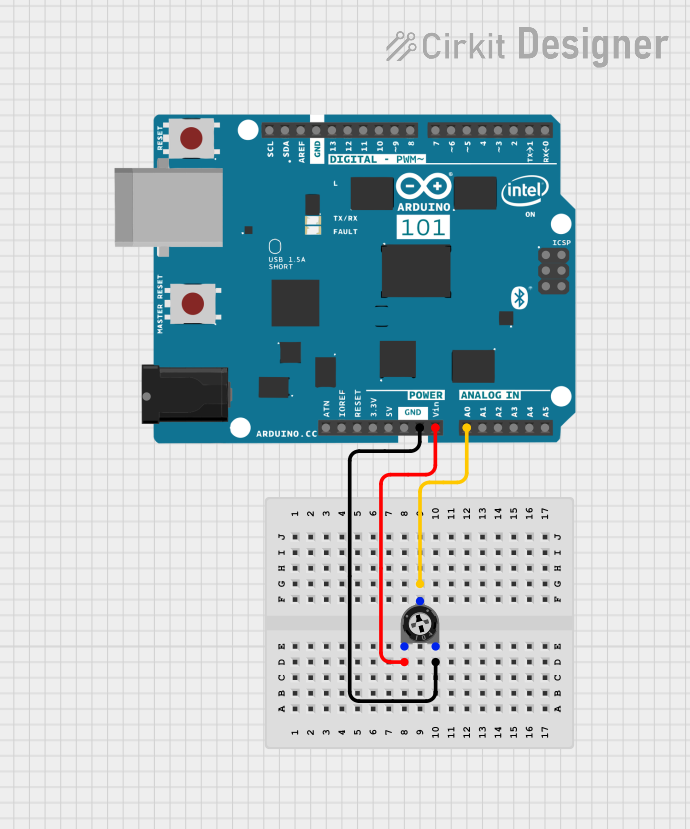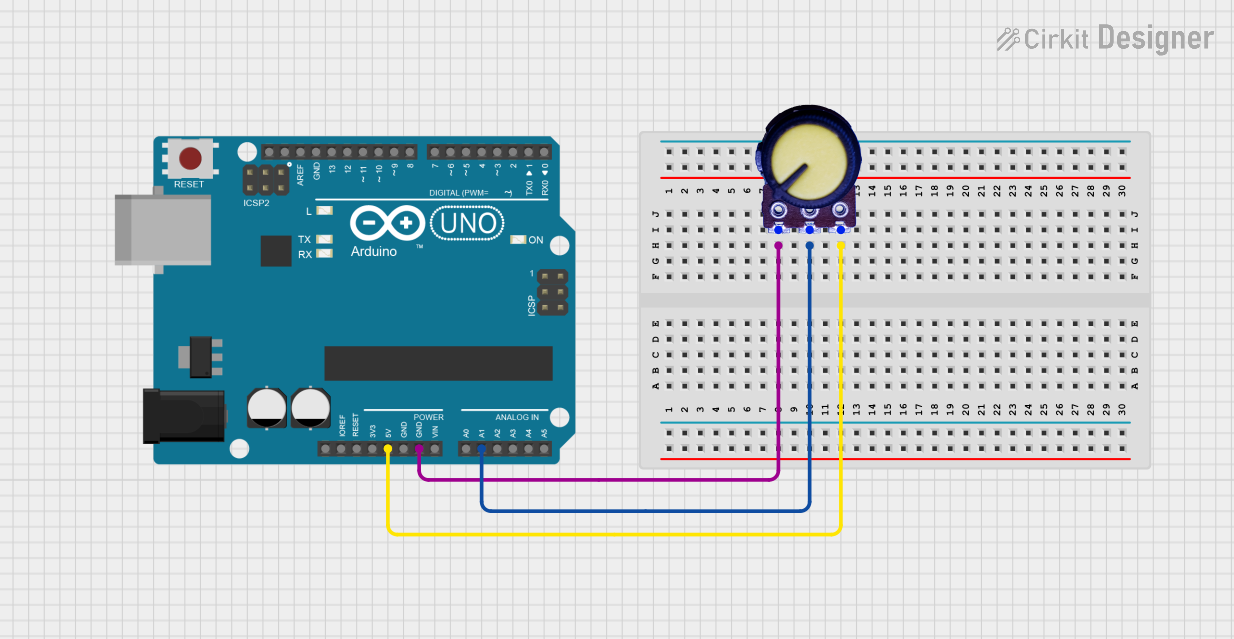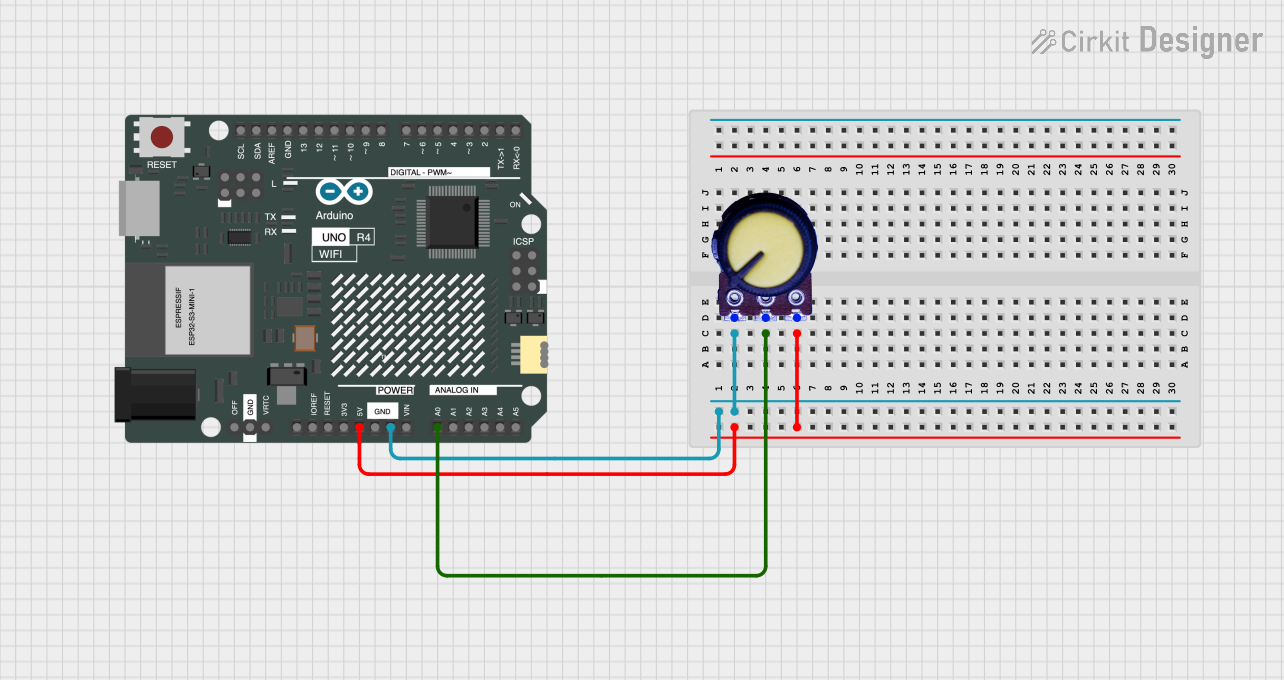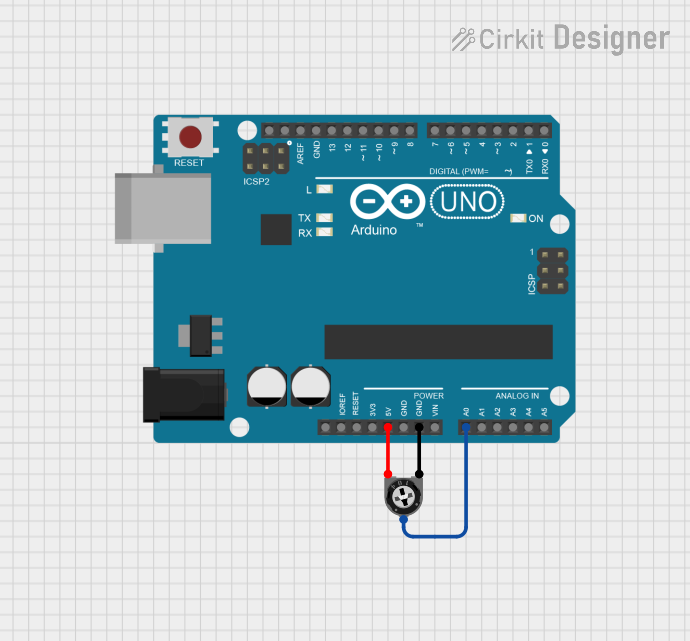
How to Use Potentiometer: Examples, Pinouts, and Specs

 Design with Potentiometer in Cirkit Designer
Design with Potentiometer in Cirkit DesignerIntroduction
A potentiometer is a three-terminal variable resistor that allows users to adjust voltage levels in a circuit. By varying its resistance, it can control current flow and signal levels, making it a versatile component in electronics. Potentiometers are commonly used for tasks such as adjusting audio volume, tuning circuits, and controlling brightness in displays.
Explore Projects Built with Potentiometer

 Open Project in Cirkit Designer
Open Project in Cirkit Designer
 Open Project in Cirkit Designer
Open Project in Cirkit Designer
 Open Project in Cirkit Designer
Open Project in Cirkit Designer
 Open Project in Cirkit Designer
Open Project in Cirkit DesignerExplore Projects Built with Potentiometer

 Open Project in Cirkit Designer
Open Project in Cirkit Designer
 Open Project in Cirkit Designer
Open Project in Cirkit Designer
 Open Project in Cirkit Designer
Open Project in Cirkit Designer
 Open Project in Cirkit Designer
Open Project in Cirkit DesignerCommon Applications and Use Cases
- Audio equipment (e.g., volume control)
- Brightness adjustment in LED circuits
- Calibration and tuning of electronic devices
- Signal conditioning in analog circuits
- User input devices (e.g., joysticks)
Technical Specifications
Below are the general technical specifications for a standard potentiometer. Note that specific values may vary depending on the model and manufacturer.
| Parameter | Specification |
|---|---|
| Resistance Range | 1 kΩ to 1 MΩ |
| Power Rating | 0.1 W to 2 W |
| Tolerance | ±10% to ±20% |
| Operating Voltage | Up to 50 V DC |
| Operating Temperature | -40°C to +125°C |
| Adjustment Type | Rotary or Linear (slider) |
| Lifespan | 10,000 to 1,000,000 cycles |
Pin Configuration and Descriptions
A potentiometer typically has three pins:
| Pin | Name | Description |
|---|---|---|
| 1 | Terminal 1 | One end of the resistive track. Connect to the voltage source or ground. |
| 2 | Wiper | The adjustable middle pin. Outputs the variable voltage based on the wiper's position. |
| 3 | Terminal 2 | The other end of the resistive track. Connect to ground or the voltage source. |
Usage Instructions
How to Use the Potentiometer in a Circuit
Basic Voltage Divider Configuration:
- Connect Terminal 1 to the positive voltage supply (e.g., 5V).
- Connect Terminal 2 to ground (GND).
- The Wiper (Pin 2) will output a variable voltage between 0V and the supply voltage, depending on the wiper's position.
Current Control:
- Use the potentiometer in series with a load to control the current flowing through the load.
Connecting to an Arduino UNO:
- A potentiometer can be used as an analog input to an Arduino. Connect the wiper to an analog input pin (e.g., A0), and the other two terminals to 5V and GND.
Example Arduino Code
The following code reads the potentiometer's value and outputs it to the Serial Monitor.
// Define the analog pin connected to the potentiometer's wiper
const int potPin = A0;
void setup() {
// Initialize serial communication at 9600 baud
Serial.begin(9600);
}
void loop() {
// Read the analog value from the potentiometer (0-1023)
int potValue = analogRead(potPin);
// Print the potentiometer value to the Serial Monitor
Serial.print("Potentiometer Value: ");
Serial.println(potValue);
// Add a small delay to stabilize readings
delay(100);
}
Important Considerations and Best Practices
- Power Rating: Ensure the potentiometer's power rating is not exceeded to avoid damage.
- Mechanical Wear: Avoid excessive force when turning the knob to prevent mechanical wear.
- Debouncing: For applications requiring precise adjustments, consider software debouncing to filter out noise.
- Mounting: Secure the potentiometer properly to prevent movement during operation.
Troubleshooting and FAQs
Common Issues and Solutions
No Output Voltage:
- Cause: Incorrect wiring.
- Solution: Verify that Terminal 1 and Terminal 2 are connected to the voltage source and ground, respectively.
Inconsistent or Noisy Output:
- Cause: Dust or wear on the resistive track.
- Solution: Clean the potentiometer with contact cleaner or replace it if worn out.
Potentiometer Not Adjusting Properly:
- Cause: Mechanical damage or incorrect connections.
- Solution: Inspect for physical damage and ensure proper wiring.
Arduino Reads Incorrect Values:
- Cause: Floating connections or noise.
- Solution: Ensure all connections are secure and use a capacitor (e.g., 0.1 µF) across the wiper and ground to reduce noise.
FAQs
Q: Can I use a potentiometer to control an LED's brightness directly?
A: Yes, but ensure the potentiometer's power rating matches the LED's current requirements. Alternatively, use the potentiometer to control a PWM signal via a microcontroller.Q: What is the difference between a linear and logarithmic potentiometer?
A: A linear potentiometer changes resistance uniformly, while a logarithmic potentiometer changes resistance exponentially, often used in audio applications.Q: Can I use a potentiometer as a rheostat?
A: Yes, by connecting only two terminals (one end terminal and the wiper), a potentiometer can function as a variable resistor (rheostat).